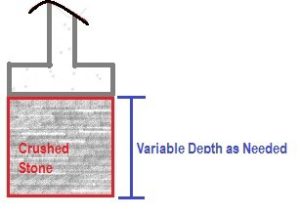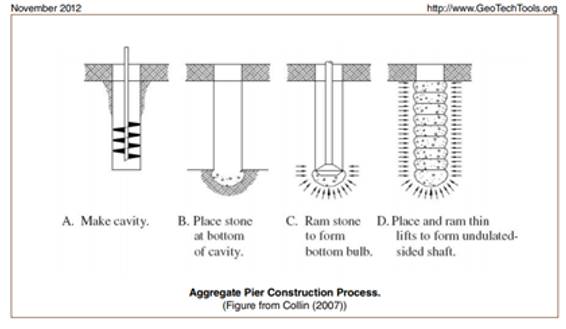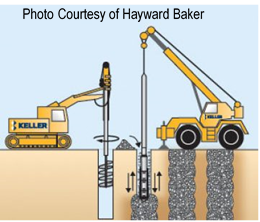Aggregate Piers – Filling the Gap
The idea of aggregate piers was initially conceived in 1988 as an effort to make stone replacement more efficient and easily implementable at a larger scale. The processes to design and construct aggregate piers have since evolved by quantum leaps, making aggregate piers a reliable and widely-accepted ground improvement method well beyond stone replacement. Aggregate piers bridge the gap between conventional foundation support and deep foundations (drilled piles, driven piles, etc.).

Stone replacement is a common, shallow ground improvement technique involving the removal of soft or loose soils from foundation excavations and then replacing the removed soils with well-compacted crushed stone base or #57 stone. Replacing soft or loose soils improves the stress-strain behavior of materials within the foundation influence zone to reduce foundation settlement. Stone replacement is generally performed to depths ranging from a few inches to as much as 2 times the footing width, depending on the actual conditions. Obviously, there are limitations to this technique including safety concerns and the ability to extend the excavation to the required depth without creating a great deal of site disturbance. Typically, stone replacement extending more than about 5 feet below foundation bearing elevation becomes impractical and unsafe.
Aggregate piers can improve the subsurface profile to a much greater depth than stone replacement, and the stiffness of the crushed stone elements proves much greater than what stone replacement can accomplish. Hence, aggregate piers can be used to economically reduce the magnitude of foundation settlement by improving the stress-strain behavior of the zone treated with aggregate piers.
In most cases, aggregate piers can fill the gap between conventional shallow foundations supported directly on the ground and the need to use piles to keep foundation settlement within tolerable limits. Typically, column loads greater than about 400 kips result in total and differential foundation settlements greater than customarily acceptable limits. Aggregate piers fill the gap spanning between about 400- and 1,200-kip foundation loads, which previously would have required the use of piles to reduce settlement.
Aggregate piers are a very good tool in the foundation support toolbox, but they are not magic. Although in many cases aggregate piers can be used successfully, there are instances when aggregate piers are simply not a good match for the site subsurface conditions. Forcing the use of aggregate piers on the wrong site can cause considerable construction schedule delays and cost overruns. Knowing when to deploy aggregate piers, and when not to, can make or break a project. Call Geo-Hydro. We know when to hold them, and when to fold them, to deliver a reliable foundation system for your project.


